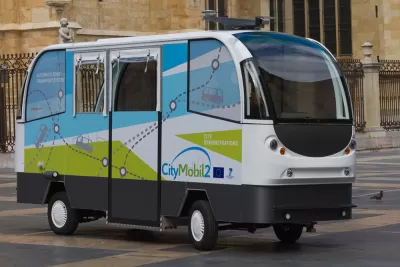Unlike the American focus on luxury personal self-drivers, the European approach favors small self-driving buses that can ferry riders to larger transit lines.

Transportation culture can be very different across the Atlantic, and that holds true when it comes to driverless vehicles. Unlike this country, where self-driving car developers focus on prestigious personal transport, the European focus is on augmenting well-developed transit systems that already exist.
Barely exceeding walking pace, many of these locally-developed vehicles fit into the self-driving bus category. They're designed to fill in that "first and last mile" between transit riders' homes and stations or stops.
Mark Scott writes, "Forgoing the latest automotive trends of aerodynamics and style, European transportation groups and city planners are instead aiming to connect these unglamorous driverless vehicles to existing public transportation networks of subways and buses."
"In total, more than 20 pilot or existing public transport programs have taken place in Europe involving autonomous vehicles [...] Most of these projects have received government funding, tapping into local research institutions and tech start-ups that are not household names."
FULL STORY: The Future of European Transit: Driverless and Utilitarian

Maui's Vacation Rental Debate Turns Ugly
Verbal attacks, misinformation campaigns and fistfights plague a high-stakes debate to convert thousands of vacation rentals into long-term housing.

Planetizen Federal Action Tracker
A weekly monitor of how Trump’s orders and actions are impacting planners and planning in America.

Chicago’s Ghost Rails
Just beneath the surface of the modern city lie the remnants of its expansive early 20th-century streetcar system.

Bend, Oregon Zoning Reforms Prioritize Small-Scale Housing
The city altered its zoning code to allow multi-family housing and eliminated parking mandates citywide.

Amtrak Cutting Jobs, Funding to High-Speed Rail
The agency plans to cut 10 percent of its workforce and has confirmed it will not fund new high-speed rail projects.

LA Denies Basic Services to Unhoused Residents
The city has repeatedly failed to respond to requests for trash pickup at encampment sites, and eliminated a program that provided mobile showers and toilets.
Urban Design for Planners 1: Software Tools
This six-course series explores essential urban design concepts using open source software and equips planners with the tools they need to participate fully in the urban design process.
Planning for Universal Design
Learn the tools for implementing Universal Design in planning regulations.
planning NEXT
Appalachian Highlands Housing Partners
Mpact (founded as Rail~Volution)
City of Camden Redevelopment Agency
City of Astoria
City of Portland
City of Laramie



























